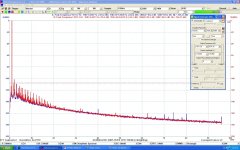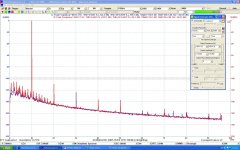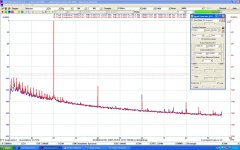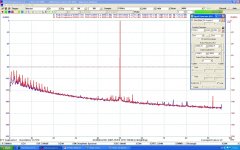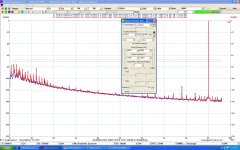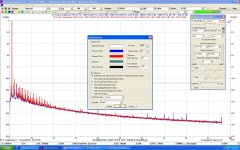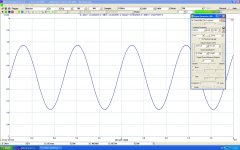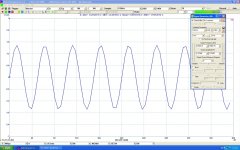ikoflexer,
My 0202 did not make it through my weekend of testing. As others have explained, and I now understand, these are great for digital analysis as the software, through the magic of math, limits the analysis to valid frequencies. I plan to get a replacement, but, I am unsure about which one to get. Please post the results of your testing. If you can do 192 kHz and 24 bit, please show results up to 96 kHz so I can get an idea of what is happening in the upper frequencies. I do not need the 192 kHz 24 bit to give the lowest THD. It is unlikely than anything I make will approach these limits, but a bit of extra information at high frequencies would be nice.
Thanks
Jim
My 0202 did not make it through my weekend of testing. As others have explained, and I now understand, these are great for digital analysis as the software, through the magic of math, limits the analysis to valid frequencies. I plan to get a replacement, but, I am unsure about which one to get. Please post the results of your testing. If you can do 192 kHz and 24 bit, please show results up to 96 kHz so I can get an idea of what is happening in the upper frequencies. I do not need the 192 kHz 24 bit to give the lowest THD. It is unlikely than anything I make will approach these limits, but a bit of extra information at high frequencies would be nice.
Thanks
Jim
Something weird going on with the ASIO drivers on the 0404 usb interface.
With the ASIO driver if I set the Virtins MI software to ouput sampling of 96kHz or 192kHz, for a 20kHz sine wave, the actual sine wave comes out as 10kHz. A sampling rate of 48kHz works fine and the output is indeed at 20kHz, as chosen.
Using the MME driver works fine, 48kHz, 96kHz, or 192kHz sampling, 20kHz outputs always a 20kHz sine. Each of them also shows a significant fft bump at kHz and 196kHz. I'll post an image of this if people are interested.
I had similar problems with 0404-USB. Concretely, i had hung-ups of software. That is caused probably from the ASIO driver of EMU. Asking Virtins tech support for this problem, they told me to try to reduce the ASIO buffer size in the MI. To this, you may select from the Setting menu the Display Setting. In the Display setting window, you can see in the bottom the ASIO Buffer Size box. Try the "Min" instead the "Max" or "Auto" settings. This helps in some instances.
As for the ASUS Xonar Essence STX that i use now, i haven't any problem with its C-Media ASIO driver. I never tried in the past a stimulus of 20KHz, but doing this just now at 192Ks/24b i had exactly the same frequency at MI FFT analyzer. I tried as well a sinus of 50KHz and the result was the same, the peak on the FFT analyzer it is exactly at 50KHz.
I will try a FFT analysis of Essence STX at high frequencies and i will post the plots obtained.
Fotios
Jim, bellow are attached five FFT plots obtained from the ASUS Xonar Essence STX in external loopback mode at 192Ks/s - 24bit with different sinusoidal signals: 1K, 10K, 20K, 50K and 90K. Although are not from an EMU (i have sold my 0404 usb) i think you can get an idea for that you want. Because i did a such test for first time, i observed some new things: As the frequency of test signal is increased, the FFT analysis shows an increasing of the Noise Level. Very interesting... I think that i can perceive now your bothering.
Attachments
Last edited:
Let's see the thing from a different optic angle. Attached are three curves obtained from the oscilloscope of Virtins MI with the same presets like in its FFT analyzer. The curves obtained from sinusoidal stimulus of 1KHz, 10KHz and 20KHz. We can observe that the 1KHz curve is almost perfect, instead the 10KHz is distorted and the 20KHz is inadmissible. Obviously this caused from the poor bandwidth of the ADC converter and not so much from the DAC of sound card. This proves that sound cards are not suitable for serious measurements of bandwidth.
Attachments
fotios,
Very good work! You demonstrated the limits quite well. The poor 20 kHz sinewave is quite obvious. I have a laptop so I was planning on getting a USB external, but your results are much better than I was getting with the 0202. I will have to consider an "upgrade" to a desktop and the ASUS card. Hopefully ikoflexer is able to get similar tests to run on the 0404. It uses different chips than the 0202 so the results will be interesting. The ability to run the FFT so easily with soundcard and computer is quite appealing and I am still interested in using this method. It is important to understand it's limits.
ikoflexer, Yes I fried it. I opened it up and can see no obvious problems. I do not know what caused it, possibly static shock, but I will check my headphone amp for DC on its output. The headphone amp is really just at the testing stage and I should not have used it during testing without some soundcard protection. I am planning on building the Peter Millett's Sound Card Interface, but am still waiting on some of the parts. Live and learn.
Jim
Very good work! You demonstrated the limits quite well. The poor 20 kHz sinewave is quite obvious. I have a laptop so I was planning on getting a USB external, but your results are much better than I was getting with the 0202. I will have to consider an "upgrade" to a desktop and the ASUS card. Hopefully ikoflexer is able to get similar tests to run on the 0404. It uses different chips than the 0202 so the results will be interesting. The ability to run the FFT so easily with soundcard and computer is quite appealing and I am still interested in using this method. It is important to understand it's limits.
ikoflexer, Yes I fried it. I opened it up and can see no obvious problems. I do not know what caused it, possibly static shock, but I will check my headphone amp for DC on its output. The headphone amp is really just at the testing stage and I should not have used it during testing without some soundcard protection. I am planning on building the Peter Millett's Sound Card Interface, but am still waiting on some of the parts. Live and learn.
Jim
@Jim, sorry to hear about the card. Well, Jim, if I were in position to get another interface for measurements I'm very much leaning towards the TI pcm4222evm. It's only an ADC eval board but it seems to have good specs and no doubt it would beat my 0404. The lack of a DAC doesn't bother me
since I'm not very thrilled with the DAC based signal generator at higher frequencies. I'd probably build a measurement box with a pcm4222evm board and a low distortion oscillator in it. Could do my own low noise power supply for it, and the total price might be below $250.
What I like about the pcm4222evm board is that you don't depend on any software. The sampling rate is chosen via jumpers.
For just doing 1kHz fft tests a card like the ASUS Xonar Essence STX seems to have very good price/performance ratio.
The 0404 is frustrating me very much at the moment. With the ASIO drivers I choose 192kHz or 96kHz sampling rate but I'm not sure at all it does it. Don't know whether to blame the Virtins software, or the ASIO drivers, but it sure doesn't work as it should. BTW, using the MME drivers work as advertised, except my Virtins MI demo copy just expired so I can't post any tests using that. I'll try ARTA perhaps.
@fotios: thanks so much for taking the time to post these results. I think you're helping a lot of people that are wondering about this.
since I'm not very thrilled with the DAC based signal generator at higher frequencies. I'd probably build a measurement box with a pcm4222evm board and a low distortion oscillator in it. Could do my own low noise power supply for it, and the total price might be below $250.
What I like about the pcm4222evm board is that you don't depend on any software. The sampling rate is chosen via jumpers.
For just doing 1kHz fft tests a card like the ASUS Xonar Essence STX seems to have very good price/performance ratio.
The 0404 is frustrating me very much at the moment. With the ASIO drivers I choose 192kHz or 96kHz sampling rate but I'm not sure at all it does it. Don't know whether to blame the Virtins software, or the ASIO drivers, but it sure doesn't work as it should. BTW, using the MME drivers work as advertised, except my Virtins MI demo copy just expired so I can't post any tests using that. I'll try ARTA perhaps.
@fotios: thanks so much for taking the time to post these results. I think you're helping a lot of people that are wondering about this.
General question to all experts. Is a generic spectrum analyzer like the HP 3585A with only 80dB dynamic range worth getting these days when you can get more dynamic range from a $150 ADC board?
@ Jim
Thanks for your kind words.
Before 2 years, i had the same thought like you, that an external usb sound card might be less noisy from an internal. For this reason i bought the EMU 0404 usb. Using it, after 1 month i ascertained some drawbacks which i had not thought from the beginning. First of all, the balanced IN/OUT of EMU it is a trouble for routing single ended signals. I tried any routing method: Shorting the -IN to GND, leaving unconnected the -IN etc. Because i execute the calibration procedure of sound card in any case, i had different measuring results each time. As well, the input and output pots of EMU usb it is a restriction factor in the precision of IN/OUT level calibration. These pots are not of good quality and have a significant tolerance. As well, the lot of switches included they affect the signal. Only then i thought, that this card is addressed in musicians. After this, i thought that i need a sound card without any pot, switch etc. At the same time, i heard about ASUS Essence STX. Immediately, i sold the EMU and i bought the Essence STX. It is really a great sound card, with top ADC and DAC converters. As i told previous, its ASIO driver of C-Media is far better from this of EMU. My fear for the possible infection from interference inside the PC, was dissolved when i checked with my DSO its real output noise which is better from EMU usb. Unfortunately, as i have mentioned in previous posts, and this card has its own drawbacks. It is very sensitive in overloading. I fried the first that i bought during loopback tests. Fortunately the shop of purchase refunded me with a new. Now i am very cautious for the input signal to not exceeds +/-1.5V.
As for the rest, because i am not a PC expert, my PC is a workstation with Intel C2D cpu, Intel M/B, and 8GB DDRAM. It runs under WinXP x64 without problems and it is included inside a Chieftek Tower server case. Maybe all these have some role in the final performance of sound card. I am sure for one thing: the heaviest FFT analysis i tried (with big FFT sizes) is executed on the fly due to big DDRAM memory, and the big L1-L2 cache memory of CPU. There are no hung-ups.
I hope the above can enlightening you, before you proceed in purchase of new devices. I don't know your economics exactly (i can suppose that are restricted, unless you could buy a luxury AP analyzer instead to mess-up with cheap measuring stuff 😀) because it is sin to spend your money in useless things under the current economic crisis. I am 52 years old, and believe me i am very 🙁 when i see young people to spend their few money (either from their part-time work for 600 euro/month in Greece, or from their pocket money) in "Life Goods" in the cost of their amusement.
Fotios
Thanks for your kind words.
Before 2 years, i had the same thought like you, that an external usb sound card might be less noisy from an internal. For this reason i bought the EMU 0404 usb. Using it, after 1 month i ascertained some drawbacks which i had not thought from the beginning. First of all, the balanced IN/OUT of EMU it is a trouble for routing single ended signals. I tried any routing method: Shorting the -IN to GND, leaving unconnected the -IN etc. Because i execute the calibration procedure of sound card in any case, i had different measuring results each time. As well, the input and output pots of EMU usb it is a restriction factor in the precision of IN/OUT level calibration. These pots are not of good quality and have a significant tolerance. As well, the lot of switches included they affect the signal. Only then i thought, that this card is addressed in musicians. After this, i thought that i need a sound card without any pot, switch etc. At the same time, i heard about ASUS Essence STX. Immediately, i sold the EMU and i bought the Essence STX. It is really a great sound card, with top ADC and DAC converters. As i told previous, its ASIO driver of C-Media is far better from this of EMU. My fear for the possible infection from interference inside the PC, was dissolved when i checked with my DSO its real output noise which is better from EMU usb. Unfortunately, as i have mentioned in previous posts, and this card has its own drawbacks. It is very sensitive in overloading. I fried the first that i bought during loopback tests. Fortunately the shop of purchase refunded me with a new. Now i am very cautious for the input signal to not exceeds +/-1.5V.
As for the rest, because i am not a PC expert, my PC is a workstation with Intel C2D cpu, Intel M/B, and 8GB DDRAM. It runs under WinXP x64 without problems and it is included inside a Chieftek Tower server case. Maybe all these have some role in the final performance of sound card. I am sure for one thing: the heaviest FFT analysis i tried (with big FFT sizes) is executed on the fly due to big DDRAM memory, and the big L1-L2 cache memory of CPU. There are no hung-ups.
I hope the above can enlightening you, before you proceed in purchase of new devices. I don't know your economics exactly (i can suppose that are restricted, unless you could buy a luxury AP analyzer instead to mess-up with cheap measuring stuff 😀) because it is sin to spend your money in useless things under the current economic crisis. I am 52 years old, and believe me i am very 🙁 when i see young people to spend their few money (either from their part-time work for 600 euro/month in Greece, or from their pocket money) in "Life Goods" in the cost of their amusement.
Fotios
In December of 2006 Bob Cordell wrote
**************
I personally use an HP 3580A, a very fine analog audio spectrum analyzer designed in the 70's. At the time it was about $10,000 when that was a lot of money. I bought it used for $700 about 9 years ago. It goes to 50 kHz and has 90 dB dynamic range. I enhance its dynamic range by 20 or 40 dB in amplifier tests by using my Distortion Magnifier described on my web site at Cordell Audio: Home Page.
More significantly, PC-based spectrum analyzers using PC sound cards are now available that put spectral analysis in the hands of just about anybody. Check out Visual Analyzer at Visual Analyser 8.30.21. If you use it with a 24-bit, 96 kHz sound card, you can get in excess of 100 dB dymanic range and get out to frequencies close to 50 kHz. It supposedly can also be used with 24-bit, 192 kHz sound cards for greater frequency range, but I have not yet located a reasonably priced sound card with 192 kHz A2D sampling rate.
For THD-20, my THD analyzer has a bandwidth out to 200 kHz, and can see 0.001% THD. But as pointed out earlier, spectral analysis of the distortion output out to only 50 kHz doesn't tell the whole story on THD-20.
***************
I think the problem is that the wonderful specs for the sound cards are true only up to 20 kHz. The trick will be to find a sound card that can work up to 24 bit 192 kHz, with low distortion and noise up to 90 kHz. It looks like fotios's card can do that.
Jim
**************
I personally use an HP 3580A, a very fine analog audio spectrum analyzer designed in the 70's. At the time it was about $10,000 when that was a lot of money. I bought it used for $700 about 9 years ago. It goes to 50 kHz and has 90 dB dynamic range. I enhance its dynamic range by 20 or 40 dB in amplifier tests by using my Distortion Magnifier described on my web site at Cordell Audio: Home Page.
More significantly, PC-based spectrum analyzers using PC sound cards are now available that put spectral analysis in the hands of just about anybody. Check out Visual Analyzer at Visual Analyser 8.30.21. If you use it with a 24-bit, 96 kHz sound card, you can get in excess of 100 dB dymanic range and get out to frequencies close to 50 kHz. It supposedly can also be used with 24-bit, 192 kHz sound cards for greater frequency range, but I have not yet located a reasonably priced sound card with 192 kHz A2D sampling rate.
For THD-20, my THD analyzer has a bandwidth out to 200 kHz, and can see 0.001% THD. But as pointed out earlier, spectral analysis of the distortion output out to only 50 kHz doesn't tell the whole story on THD-20.
***************
I think the problem is that the wonderful specs for the sound cards are true only up to 20 kHz. The trick will be to find a sound card that can work up to 24 bit 192 kHz, with low distortion and noise up to 90 kHz. It looks like fotios's card can do that.
Jim
General question to all experts. Is a generic spectrum analyzer like the HP 3585A with only 80dB dynamic range worth getting these days when you can get more dynamic range from a $150 ADC board?
I am not sure for this. But we may not disdain the old good instruments. I have a THANDAR workbench multimeter of 3.5 digits (bought at 1985) which don't refer that it has true RMS voltmeter. To my big surprise, before 2 years i discovered that its AC measurements are expressed in true RMS and are very accurate up to 150KHz at least.
I have a question. You are looking to use this PCM4222evm as ADC. Very nice. But you need as well a FFT software. So, you need a driver software to communicate the ADC board with the FFT software. I don't know what have in your mind. If you know to write the code of driver, then go ahead. BTW, the last Virtins MI v3.2 offers the possibility to use a custom made ADC and DAC device. If you open the Setting menu--> ADC device database, in the last line of the list you can see "My DAQ". The same in DAC device database, in the last line you can see "My DAO". In the last pages of MI manual, there is a very good tutorial with instructions of how you can write your own driver for your custom ADC/DAC device. Virtins MI v3.2 offers as well a wonderfull simulator, which helps in debugging the code. With little effort and study of manual, i think that you can obtain what have in your mind.
Fotios
Sorry for the misinformation. The user guide for writing codes and the simulator executable archive, are found in the root directory where is installed the Virtins MI Pro 3.2. You can't use them from the FFT analyzer.
Check your HDD where is placed the directory. You can download as well, tutorials about FFT analysis etc from the Virtins site in pdf.
Check your HDD where is placed the directory. You can download as well, tutorials about FFT analysis etc from the Virtins site in pdf.
Actually, it's supposed to have digital output which can be piped into a sound card with digital output. I'm not sure I'll get it, but I'm seriously considering it as a clean and upgradeable adc board.
From the data sheet:
"The primary features of the PCM4222EVM include:
· Simple configuration using switches and power-supply jumpers.
· Two differential input buffer/filter circuits employing the Texas Instruments OPA1632 fully differential
amplifer integrated circuit.
· Two Texas Instruments DIT4192 digital audio interface transmitters, providing AES3-encoded output
data. Transformer coupled 110W balanced and 75W unbalanced outputs are provided. Single-Channel,
Double Sampling Frequency operation is supported.
· A buffered audio serial port header supports connection to external hardware or test equipment
supporting Philips' I2S™, Left Justified, or Time Division Multiplexed (TDM) audio interface formats for
PCM output data.
· A buffered data port header provides one-bit Direct Stream Digital (DSD) output data and the
associated bit clock for the DSD output.
· A buffered modulator output port header provides access to the PCM4222 6-bit modulator data outputs
and clocks.
· Support for onboard or external clock generation. Two onboard crystal oscillators provide support for
common audio sampling rates, including 44.1kHz, 48kHz, 88.2kHz, 96kHz, 176.4kHz, and 192kHz.
· Light emitting diode (LED) overflow indicators for the left and right audio channels.
· Minimum power-supply requirements: ±6V to ±15V for the analog section, and +5V for the digital
section.
· The PCM4222 analog supply may be generated from an onboard +4.0 linear voltage regulator, or an
external regulated dc power source.
· A +3.3V supply, used to power the majority of the digital circuitry and the PCM4222 digital section,
may be generated from the +5.0V digital supply using an onboard linear voltage regulator.
Alternatively, an external regulated dc power source may be selected, supporting digital supply
voltages as low as +2.4V."
From the data sheet:
"The primary features of the PCM4222EVM include:
· Simple configuration using switches and power-supply jumpers.
· Two differential input buffer/filter circuits employing the Texas Instruments OPA1632 fully differential
amplifer integrated circuit.
· Two Texas Instruments DIT4192 digital audio interface transmitters, providing AES3-encoded output
data. Transformer coupled 110W balanced and 75W unbalanced outputs are provided. Single-Channel,
Double Sampling Frequency operation is supported.
· A buffered audio serial port header supports connection to external hardware or test equipment
supporting Philips' I2S™, Left Justified, or Time Division Multiplexed (TDM) audio interface formats for
PCM output data.
· A buffered data port header provides one-bit Direct Stream Digital (DSD) output data and the
associated bit clock for the DSD output.
· A buffered modulator output port header provides access to the PCM4222 6-bit modulator data outputs
and clocks.
· Support for onboard or external clock generation. Two onboard crystal oscillators provide support for
common audio sampling rates, including 44.1kHz, 48kHz, 88.2kHz, 96kHz, 176.4kHz, and 192kHz.
· Light emitting diode (LED) overflow indicators for the left and right audio channels.
· Minimum power-supply requirements: ±6V to ±15V for the analog section, and +5V for the digital
section.
· The PCM4222 analog supply may be generated from an onboard +4.0 linear voltage regulator, or an
external regulated dc power source.
· A +3.3V supply, used to power the majority of the digital circuitry and the PCM4222 digital section,
may be generated from the +5.0V digital supply using an onboard linear voltage regulator.
Alternatively, an external regulated dc power source may be selected, supporting digital supply
voltages as low as +2.4V."
@ ikoflexer
I don't know my friend. I have read the PCM4222evm data sheet already. Personally, i am with you. I am tired from sound cards. The one is noisy, the other is delicate in overloading, the third has bad ASIO and so on...
I tried to protect the input of my Essence STX with clamping diodes, and its performance derated.
The perfect solution could be an ADC/DAC like PCM2902 of TI (which includes everything and can be recognized directly from windows as audio codec device) with better performance.
Take a look please, at the last pages of Virtins MI manual. There are direct links to the data which i mentioned before. Maybe there is the solution? I don't know. I had no time to read these in detail.
May the force be with you.
I don't know my friend. I have read the PCM4222evm data sheet already. Personally, i am with you. I am tired from sound cards. The one is noisy, the other is delicate in overloading, the third has bad ASIO and so on...
I tried to protect the input of my Essence STX with clamping diodes, and its performance derated.
The perfect solution could be an ADC/DAC like PCM2902 of TI (which includes everything and can be recognized directly from windows as audio codec device) with better performance.
Take a look please, at the last pages of Virtins MI manual. There are direct links to the data which i mentioned before. Maybe there is the solution? I don't know. I had no time to read these in detail.
May the force be with you.
The pcm4222evm needs input protection as well. But there might be ways to do it without much performance loss. It's a subject I don't know much about. Low capacitance, low leakage? Low leakage schottkys? jfet diodes? What do the experts say?
http://focus.ti.com/lit/an/sboa058/sboa058.pdf
http://www.analog.com/static/imported-files/tutorials/MT-069.pdf
How to use diodes for overvoltage protection of sensitive amplifier circuits | Automotive DesignLine
Overvoltage Protection (OVP) for Sensitive Amplifier Applications - Maxim
http://focus.ti.com/lit/an/sboa058/sboa058.pdf
http://www.analog.com/static/imported-files/tutorials/MT-069.pdf
How to use diodes for overvoltage protection of sensitive amplifier circuits | Automotive DesignLine
Overvoltage Protection (OVP) for Sensitive Amplifier Applications - Maxim
A somewhat inconclusive update. Got some LME49720 little buggers today, which, besides being unity gain stable, claim the following:
"Key Specification
■ Power Supply Voltage Range ±2.5V to ±17V
■ THD+N (AV = 1, VOUT = 3VRMS, fIN = 1kHz)
RL = 2kΩ 0.00003% (typ)
RL = 600Ω 0.00003% (typ)
■ Input Noise Density 2.7nV/ rtHz (typ)
■ Slew Rate ±20V/μs (typ)
■ Gain Bandwidth Product 55MHz (typ)
■ Open Loop Gain (RL = 600Ω) 140dB (typ)
■ Input Bias Current 10nA (typ)
■ Input Offset Voltage 0.1mV (typ)
■ DC Gain Linearity Error 0.000009%"
This definitely looks on paper better than the 15532 opamp used at the input of 0404. The result was that the 0404 doesn't start properly every single time. The LEDs keep going on and off. Probably oscillating. But when it does start, the noise floor seems lower. Hard to rely on my memory, because the Virtins MI demo software ran out of time so I'm using ARTA now. The two of them did not agree in the first place. So it goes...
I'm waiting for some ada4899-2 and ad8599 to arrive, which I'll try next.
"Key Specification
■ Power Supply Voltage Range ±2.5V to ±17V
■ THD+N (AV = 1, VOUT = 3VRMS, fIN = 1kHz)
RL = 2kΩ 0.00003% (typ)
RL = 600Ω 0.00003% (typ)
■ Input Noise Density 2.7nV/ rtHz (typ)
■ Slew Rate ±20V/μs (typ)
■ Gain Bandwidth Product 55MHz (typ)
■ Open Loop Gain (RL = 600Ω) 140dB (typ)
■ Input Bias Current 10nA (typ)
■ Input Offset Voltage 0.1mV (typ)
■ DC Gain Linearity Error 0.000009%"
This definitely looks on paper better than the 15532 opamp used at the input of 0404. The result was that the 0404 doesn't start properly every single time. The LEDs keep going on and off. Probably oscillating. But when it does start, the noise floor seems lower. Hard to rely on my memory, because the Virtins MI demo software ran out of time so I'm using ARTA now. The two of them did not agree in the first place. So it goes...
I'm waiting for some ada4899-2 and ad8599 to arrive, which I'll try next.
In December of 2006 Bob Cordell wrote
**************
I personally use an HP 3580A, a very fine analog audio spectrum analyzer designed in the 70's. At the time it was about $10,000 when that was a lot of money. I bought it used for $700 about 9 years ago. It goes to 50 kHz and has 90 dB dynamic range. I enhance its dynamic range by 20 or 40 dB in amplifier tests by using my Distortion Magnifier described on my web site at Cordell Audio: Home Page.
More significantly, PC-based spectrum analyzers using PC sound cards are now available that put spectral analysis in the hands of just about anybody. Check out Visual Analyzer at Visual Analyser 8.30.21. If you use it with a 24-bit, 96 kHz sound card, you can get in excess of 100 dB dymanic range and get out to frequencies close to 50 kHz. It supposedly can also be used with 24-bit, 192 kHz sound cards for greater frequency range, but I have not yet located a reasonably priced sound card with 192 kHz A2D sampling rate.
For THD-20, my THD analyzer has a bandwidth out to 200 kHz, and can see 0.001% THD. But as pointed out earlier, spectral analysis of the distortion output out to only 50 kHz doesn't tell the whole story on THD-20.
***************
I think the problem is that the wonderful specs for the sound cards are true only up to 20 kHz. The trick will be to find a sound card that can work up to 24 bit 192 kHz, with low distortion and noise up to 90 kHz. It looks like fotios's card can do that.
Jim
Hi Jim,
Since the time of that quote I have gotten a Juli@ card and it seems to perform quite well.
Cheers,
Bob
Thanks Bob,
It seems there are a few cards that are useful at higher frequencies. I have read that the M-Audio 192 also works well. I've come to the conclusion that an internal card will be my best choice. Unfortunately my workshop is more than a little too full to add a permanent desktop computer. It would just add to my space problems. I am trying to work out a deal with my daughter for temporary use of her desktop when testing. I would buy one of these "good" internal cards for her computer. She is bargaining hard and wants equal rights on my laptop. I'm hoping she will accept access to my wifes laptop. The only problem I have now is telling my wife about this plan.
Jim
It seems there are a few cards that are useful at higher frequencies. I have read that the M-Audio 192 also works well. I've come to the conclusion that an internal card will be my best choice. Unfortunately my workshop is more than a little too full to add a permanent desktop computer. It would just add to my space problems. I am trying to work out a deal with my daughter for temporary use of her desktop when testing. I would buy one of these "good" internal cards for her computer. She is bargaining hard and wants equal rights on my laptop. I'm hoping she will accept access to my wifes laptop. The only problem I have now is telling my wife about this plan.
Jim
Complete test report of EMU-Tracker Pre from Virtins
That is a great test report (52 pages!) for your eyes only, lucky owners of EMU-Tracker Pre from Virtins:
http://www.virtins.com/doc/D1004/EMU_Tracker_Pre_Report_D1004.pdf
Fotios
That is a great test report (52 pages!) for your eyes only, lucky owners of EMU-Tracker Pre from Virtins:
http://www.virtins.com/doc/D1004/EMU_Tracker_Pre_Report_D1004.pdf
Fotios
- Status
- Not open for further replies.
- Home
- Amplifiers
- Solid State
- Issues with Emu tracker and THD measurements
